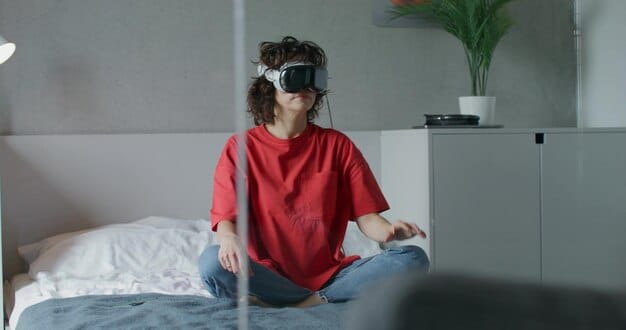The $500 Mental Wellness Tech Upgrade: Is It Worth It?

The $500 Mental Wellness Tech Upgrade: Is It Worth the Investment? explores whether the benefits of investing in mental wellness technology, such as apps and devices, justify the cost, considering factors like efficacy, user experience, and long-term mental health improvements.
Considering a $500 mental wellness tech upgrade? You’re not alone! Many are curious if the latest apps and gadgets can truly boost their well-being or if it’s just an expensive trend. Let’s dive in to see if the investment is worth it.
Exploring the Landscape of Mental Wellness Tech
The mental wellness tech industry is booming, offering a wide array of solutions designed to improve mental health. From meditation apps to sophisticated biofeedback devices, the options can be overwhelming. Understanding this landscape is the first step in determining whether a $500 investment is worthwhile.
Many individuals are turning to technology for help with stress, anxiety, and overall mental well-being. But with so many choices, it’s important to know what’s out there and how effective these tools really are.
Popular Mental Wellness Apps
Mental wellness apps are a common entry point into this tech space. Here are some of the most popular:
- Meditation Apps: Platforms like Calm and Headspace offer guided meditations and mindfulness exercises.
- Therapy Apps: Services such as Talkspace and BetterHelp connect users with licensed therapists for virtual counseling.
- Mood Tracking Apps: Apps like Daylio help users track their mood and identify patterns in their emotional state.

These apps provide convenient access to mental wellness tools, but it’s crucial to assess their actual impact on your mental health.
Analyzing the $500 Budget: What Can You Get?
A $500 budget can open doors to a variety of mental wellness tech options. From premium app subscriptions to wearable devices, understanding where your money goes is critical. Let’s break down the possibilities.
Deciding how to allocate your budget depends on your specific needs. Do you prefer immersive experiences or data-driven insights?
Subscription Services vs. One-Time Purchases
Consider the trade-offs between subscription-based services and one-time purchases. Subscriptions offer ongoing access to resources, while one-time purchases provide permanent ownership.
- Subscription-Based Services: Premium subscriptions to meditation or therapy apps often range from $50 to $150 per year.
- Wearable Devices: Devices like Muse or Fitbit provide biofeedback and data tracking for a one-time cost of around $200 to $300.
- Combination: You could opt for a mid-tier app subscription combined with a lower-cost wearable for a balanced approach.
Understanding these options can help you tailor your budget to your specific needs.
The Science Behind Mental Wellness Tech
It’s important to examine the scientific evidence supporting the efficacy of these technologies. Not all mental wellness tech is created equal. Some products have robust research backing their claims, while others rely more on anecdotal evidence.
Many people are skeptical about the benefits of mental wellness tech, but rigorous studies exist to support some of these tools.
Evaluating Research Studies
When exploring mental wellness tech, consider the following questions about the research:
- Peer-Reviewed Studies: Has the technology been evaluated in peer-reviewed journals?
- Sample Size: Were the studies conducted with a large and diverse sample?
- Control Groups: Did the studies include control groups to compare the technology’s effects against a placebo or standard treatment?
Looking into the scientific evidence helps ensure you’re making informed decisions about your mental health.
User Experience: How Easy Is It to Integrate Into Your Life?
The best mental wellness tech in the world is useless if it’s not easy to use. User experience plays a critical role in determining whether a $500 investment is worthwhile. Seamless integration into your daily routine is key.
Finding tech that fits your lifestyle can make all the difference in achieving the desired outcomes.
Ease of Use and Accessibility
Consider the following factors when evaluating user experience:
- Intuitive Interface: Is the app or device easy to navigate?
- Convenience: Can you easily access the technology when you need it?
- Personalization: Does the tech allow you to customize features to fit your preferences?
User-friendly tech can support your mental wellness goals without adding extra stress.

Potential Benefits of Investing in Mental Wellness Tech
Investing in mental wellness tech can offer a range of benefits, from stress reduction to improved sleep. But it’s essential to have realistic expectations and understand that tech is just one piece of the puzzle.
Using tech for mental wellness can be a great way to supplement traditional practices and enhance your overall well-being.
Specific Benefits to Consider
Here are some potential benefits to consider:
- Stress Reduction: Meditation and mindfulness apps can help lower stress levels.
- Improved Sleep: Some devices and apps are designed to improve sleep quality.
- Anxiety Management: Therapy apps and biofeedback devices can assist in managing anxiety symptoms.
It’s important to note that individual results may vary, and mental wellness tech should not replace professional care when needed.
Potential Drawbacks and Considerations
While mental wellness tech offers many benefits, it’s essential to be aware of potential drawbacks. Over-reliance on technology, data privacy concerns, and the risk of digital addiction are all important considerations.
Before investing in mental wellness tech, weigh the pros and cons to make an informed decision.
Drawbacks to Keep in Mind
Consider these potential drawbacks:
- Data Privacy: Mental wellness tech often collects personal data. Ensure the technology has strong privacy policies.
- Over-Reliance: Depending too much on tech can detract from face-to-face interactions and traditional coping mechanisms.
- Cost: Long-term subscription costs can add up, so consider the overall financial commitment.
Being mindful of these drawbacks can help you use mental wellness tech responsibly.
Making an Informed Decision: Is It Worth the Investment?
So, is the $500 mental wellness tech upgrade worth the investment? The answer depends on your individual needs, preferences, and circumstances. Consider your goals, budget, and willingness to integrate technology into your mental wellness routine.
Take the time to research and experiment with different options before committing to a purchase.
Conclusion
Ultimately, the effectiveness of a $500 mental wellness tech upgrade hinges on individual needs and preferences. By carefully evaluating the available options, weighing potential benefits and drawbacks, and considering personal circumstances, consumers can make informed decisions that enhance their mental well-being. Whether it’s a subscription to a top-tier meditation app or a cutting-edge wearable device, the key lies in finding tools that seamlessly integrate into daily life and truly resonate with one’s unique path to wellness.
| Key Point | Brief Description |
|---|---|
| 🧘 Meditation Apps | Guided sessions for stress reduction and mindfulness. |
| 🧠 Therapy Apps | Virtual counseling with licensed therapists. |
| 📊 Mood Tracking | Monitor emotions to identify patterns. |
| ⌚ Wearable Devices | Track biofeedback for deeper insights. |
Frequently Asked Questions
With a $500 budget, you can explore options like premium subscriptions to meditation apps, wearable stress trackers, or even affordable VR headsets with mental wellness programs.
Some apps are backed by research, showing effectiveness in reducing stress or improving sleep, but it’s important to check for peer-reviewed studies before investing.
Consider your specific mental health goals, preferences for technology, and research reviews to find the best fit. Free trials can also help you test out different options.
Potential downsides include privacy concerns, over-reliance on technology, and the possibility of exacerbating anxiety if not used mindfully. Balance is key.
Mental wellness tech is often a helpful supplement to traditional therapy, but shouldn’t replace professional assistance when required. Assess your particular needs and seek guidance appropriately.
Conclusion
Deciding on the $500 mental wellness tech upgrade ultimately boils down to individual needs and circumstances. Weigh your options, consider the research, and choose tools that genuinely resonate with your personal well-being journey.





